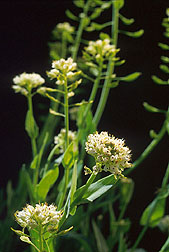This page has been archived and is being provided for reference purposes only. The page is no longer being updated, and therefore, links on the page may be invalid.
|
Acidifying Soil Helps Plant Remove Cadmium, Zinc Metals
By Sharon DurhamJune 14, 2005
Acidifying cadmium-contaminated soil can help a plant called alpine pennycress to remove even more cadmium and zinc from contaminated soil, Agricultural Research Service (ARS) and cooperating scientists report.
ARS agronomist Rufus Chaney and University of Maryland colleagues Shengchun Wang and Scott Angle have found lowering the soil pH—increasing its acidity—can maximize the ability of alpine pennycress (Thlaspi caerulescens) to remove cadmium and zinc metals from soil.
The scientists used a particular strain of alpine pennycress from southern France in their research. In the study, they increased the acidity of two soils collected at different fields near a zinc smelter at Palmerton, Pa. The pH of the soils was lowered from a neutral level of 7 to an acidic level of about 4.7 by using sulfur.
Alpine pennycress was grown on these soils for six months and then analyzed. As the pH was lowered, concentration of cadmium in the plant shoots rose. But if the pH was lowered below 6, the soils were so acidic that the alpine pennycress yields were reduced.
Alpine pennycress can concentrate cadmium in its leaves up to about 8,000 parts per million. Harvesting the above-ground vegetation annually makes it possible to gradually reduce the soil concentration of cadmium to safe levels. The cost of this remediation method, called phytoextraction, costs about $250 to $1,000 per acre per year, according to Chaney. He's based at the ARS Animal Manure and By-Products Laboratory in Beltsville, Md.
The alternative clean-up method—removal and replacement with clean soil—costs about $1 million per acre. Most highly contaminated soils can be deemed safe after three to 10 years of phytoextraction, an effective clean-up at far lower cost. The technology will be especially useful in cleaning up rice paddy soils in Asia, where mine waste contamination is causing human health effects from cadmium accumulated in rice grain.
In 2000, a patent was filed by the University of Maryland on the use of alpine pennycress for the phytoextraction of cadmium from soil, and a patent has been granted in Australia. No other similar technologies currently exist for remediation of cadmium contaminated soils using plants.
ARS is the U.S. Department of Agriculture's chief in-house scientific research agency.


